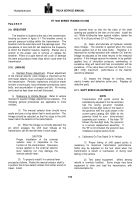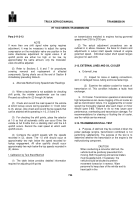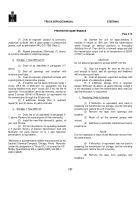TM-5-3805-254-14-P-2 - Page 706 of 894
TRUCK SERVICE MANUAL
Para 3-1/3-3
Section 3.
PREVENTIVE MAINTENANCE
3-1.
SCOPE OF SECTION 3
This
section
covers
routine
and
periodical
procedures required to maintain the transmission in good
operating condition.
Included are instructions for
inspection, care of the oil system and breather, linkage
adjustment, care of external lines, oil filter and oil cooler,
stall testing, storage, and checking oil pressures.
Troubleshooting information is tabulated at the end of
this section.
3-2.
INSPECTION AND CARE
The transmission should be kept clean to make
inspection easier.
Check for loose bolts, loose or leaking
oil lines, oil leakage, and condition of control linkage and
cables.
Check the transmission oil level at the intervals
specified in the vehicle operator’s manual.
3-3.
CHECKING OIL LEVEL
a.
Importance of Proper Level.
Maintaining the
proper oil level is very important.
If, during check
procedure (d.
below), inconsistent dipstick readings
occur, look for proper venting of the transmission
breather (para 3-9).
The transmission oil is used to
apply clutches and lubricate and cool the components.
If
the oil level is too low the result can be poor performance
(clutches will not receive adequate oil supply).
If the oil
level is too high, overheating results from the oil being
churned and aerated.
Drain any excess oil to restore the
proper level; refer to e, below.
b. Foaming and Aerating
(1)
Transmission performance will be affected
when the oil foams or aerates.
The primary causes of
aeration are, low oil in the sump, too much oil in the
sump, or a defective or missing seal-ring on the intake
pipe.
(2)
A low oil level (denoted on the dipstick) will
not completely envelope the oil filter.
Therefore oil and
air is drawn by the
input pump and is directed to the clutches and converter,
causing converter cavitational noises and irregular
shifting.
The aeration also changes the viscosity and
color to a thin milky liquid.
(3)
The normal oil level (full mark ,n dipstick)
is 1 1/2 inches (38.9 mm) below the oil pan split line.
The full mark should not be exceeded.
(4)
A defective seal-ring 24 (A, foldout 14) on
the filter intake pipe will cause the input pump to draw air
into the oil system.
Air thus entering the oil will result in
the conditions described in (2), above.
c. Protect Fill Pipe.
When adding oil or checking oil
level, dirt or foreign material must not be allowed to enter
the fill pipe.
Before removing the dipstick, clean around
the end of the fill pipe.
d. Oil Level Check Procedure.
Transmission
speed and oil temperature significantly affect the oil level.
Thus, the speed and temperature must be controlled for
an accurate c h e c k.
The oil I e v e l should be checked
by the following procedure.
(1)
Operate
the transmission until normal
operating temperature (160 to 200°F) is reached.
(2)
Shift the transmission through all drive
ranges to fill the clutch cavities and oil passages.
(3)
With the vehicle positioned on level
ground, allow the engine to idle.
Shift to neutral and
apply the parking brake.
699
TRANSMISSION
Back to Top




















